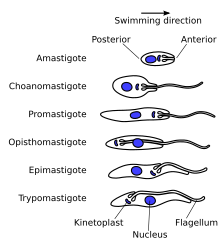Trypanosoma
Trypanosoma is a genus of kinetoplastids (class Trypanosomatidae[1]), a monophyletic[2] group of unicellular parasitic flagellate protozoa.
The mitochondrial genome of the Trypanosoma, as well as of other kinetoplastids, known as the kinetoplast, is made up of a highly complex series of catenated circles and minicircles and requires a cohort of proteins for organisation during cell division.
[8] A number of different methods demonstrate that the traditional Trypanosoma genus is not monophyletic, with the biflagellate Bodonida nested within.
[10] Salivarians are trypanosomes of the subgenera of Duttonella, Trypanozoon, Pycnomonas and Nannomonas, which are passed to the vertebrate recipient in the saliva of the tsetse fly (Glossina spp.).
[13] Stercorians are trypanosomes passed to the recipient in the feces of insects from the subfamily Triatominae (most importantly Triatoma infestans).
[citation needed] The ancestor of modern trypanosomes absorbed a green alga around one billion years ago and co-opted some of its genetic material.
This has resulted in modern trypanosomes such as T. brucei containing essential genes for the breakdown of sugars that are most closely related to plants.
[citation needed] Stercorarian trypanosomes infect insects, most often the triatomid kissing bug, by developing in the posterior gut followed by release into the feces and subsequent depositing on the skin of the vertebrate host.
[citation needed] As trypanosomes progress through their life cycle they undergo a series of morphological changes as is typical of trypanosomatids.
[26][27] An adaptive benefit of meiosis for T. crucei and T. brucei may be the recombinational repair of DNA damages that are acquired in the hostile environment of their respective hosts.
